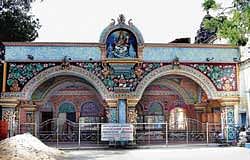A cornucopia of knowledge

Tucked away in a quiet corner of the erstwhile Maratha Kings Palace in Thanjavur here, the history of the Serfoji's Sarasvati Mahal Library (SSML) may seem no more than a footnote to an off-colour historical era.
But take a few more steps - with or without a guide - the extraordinary spirit it embodies as a treasure-trove of knowledge, wisdom and ancient arts, the tranquil halls and the narrow passages to it, reveal a little read text.
A repository of one of the largest collections of rare manuscripts in the country in 'Granth', 'Devnagari', 'Nandi Nagari', Telugu, Marathi and Tamil' scripts among others, spanning varied subjects from religion, philosophy, and medicinal systems to architecture, SSML is one of the few existing institutional links between medieval and modern India.
Historically, SSML was part of a select club globally even those days, as its records speak of it as "one of the few medieval libraries that exist in the World". Initially conceived and christened the 'Royal Palace Library' under the reign of the Nayak Kings of Thanjavur (1535-1676 AD), aimed at 'intellectual enrichment' of Hindustan's composite culture, not many then thought it would evolve into a priceless wonder and window to the World.
Fortunately, as the passionate historian and present librarian of the SSML, Mr P Perumal, told Deccan Herald, the subsequent Maratha Kings of Thanjavur really nourished its growth. The crowning glory came during the reign of Serfoji Maharaja-II (1798-1832), who despite severe resource and other constraints amid political flux built it into a world class library.
So much so, when SSML later caught the fancy of the colonial powers in London, the then British rulers sought to cut a deal with one of the queens of the Serfoji line, Kamatchi Bai Saheb. She was the first of the 17 wives of Shivaji II, the son of Serfoji II, who married so frequently to have a male successor without any luck. Shivaji II ended up having more daughters.
However, when the chips were down, it was the royal womenfolk who defended SSML's prestige. Queen Kamatchi "refused to part with the library" for an unimaginable 50,000 Pounds those days, recalls Perumal, quoting from documents. Successive wives and daughters of Shivaji II took care of the Library till 1918 when the then Madras Government appointed an 'administrative committee' headed by the District Collector to oversee it.
What then is so unique about the SSML? Serfoji II, a noted pupil of great German Missionary, Swartz, records tell us, was a versatile, multi-faceted intellectual himself with a passion for knowledge and arts. But just one year into his reign, the British captured Thanjavur, entered into a treaty and made Serfoji a 'titular King' with an annual grant.
That seemed a blessing in disguise. Tactfully, as a friend of the British, Serfoji II spent much of his time developing the liberal arts and literature and prepared the first catalogue for the library in 1801, points out Perumal.
The king started a hospital in the palace itself and every recipe prescribed to patients - be it under 'Siddha', 'Ayurveda' or allopathy, he had them recorded in palm leaf manuscripts. They are being published by the library since 1950, a major contribution to pharmacopoeia.
The King took a 'great pilgrimage' to Benares in 1820 on horseback, taking along with him more than 300 aides, including copyists and library assistants. En route, wherever they came across old texts or manuscripts, his entourage faithfully copied them, all for the SSML.
In 1824, Serfoji II became a member of the Royal Asiatic Society in London. He began to receive a copy of every book published there, in addition to his own impressive personal collection of 5,000 books in major European languages. Of the 49,000-plus manuscripts with the SSML now, 25,000 are palm-leaf manuscripts, and about 24,000 in 'paper-palm' besides 65,000 books, says Perumal. That was how Serfoji II ensured that the library was both classical and contemporary, he explains.
The earliest manuscript at SSML is the 11th century 'Phalavathi' in 'Granth' script, a philosophical treatise on palm-leaf. The oldest paper manuscript in Sanskrit, 'Bhamathi', is dated to 1476. One very rare manuscript in 'Granth', is a miraculous production in the art of writing, says Perumal. Read from left to right, it tells you the story of the 'Ramayana' and from right to left, it brings before you the story of the 'Mahabharata' epic.
Want to know about the penal system in China in the 1800s? Or dip into a Muslim poet Amber Husaini's Marathi commentary on 'Bhagavat Gita', or for that matter, have a glimpse of the 'Rig Veda' in 64 pictures? Then SSML is a must-visit place, which also abounds in old maps and atlases, the famous Samuel Johnson's V edition of the massive English Dictionary (1784), besides a rich variety of books on literature, philosophy, religion, arts and exquisite paintings.
Deccan Herald is on WhatsApp Channels| Join now for Breaking News & Editor's Picks